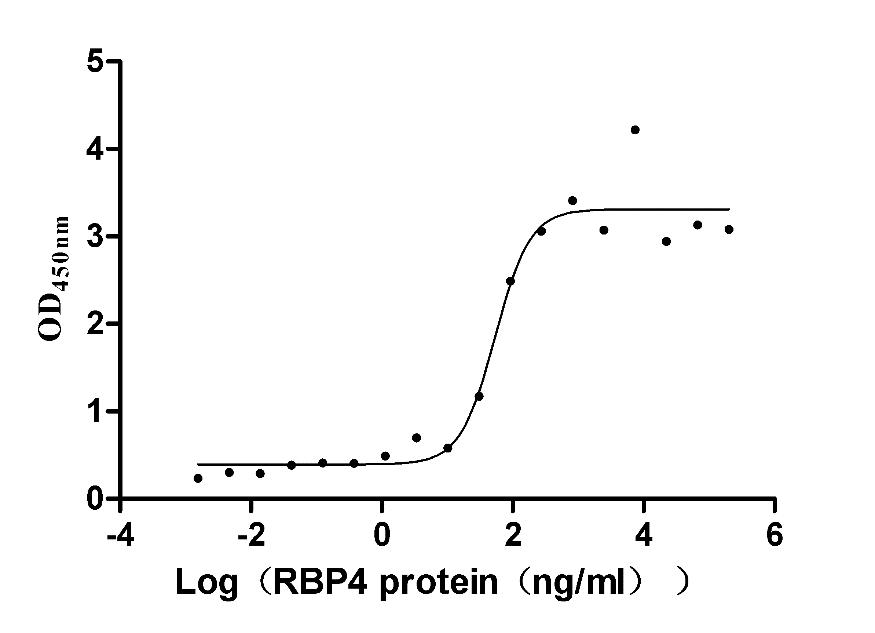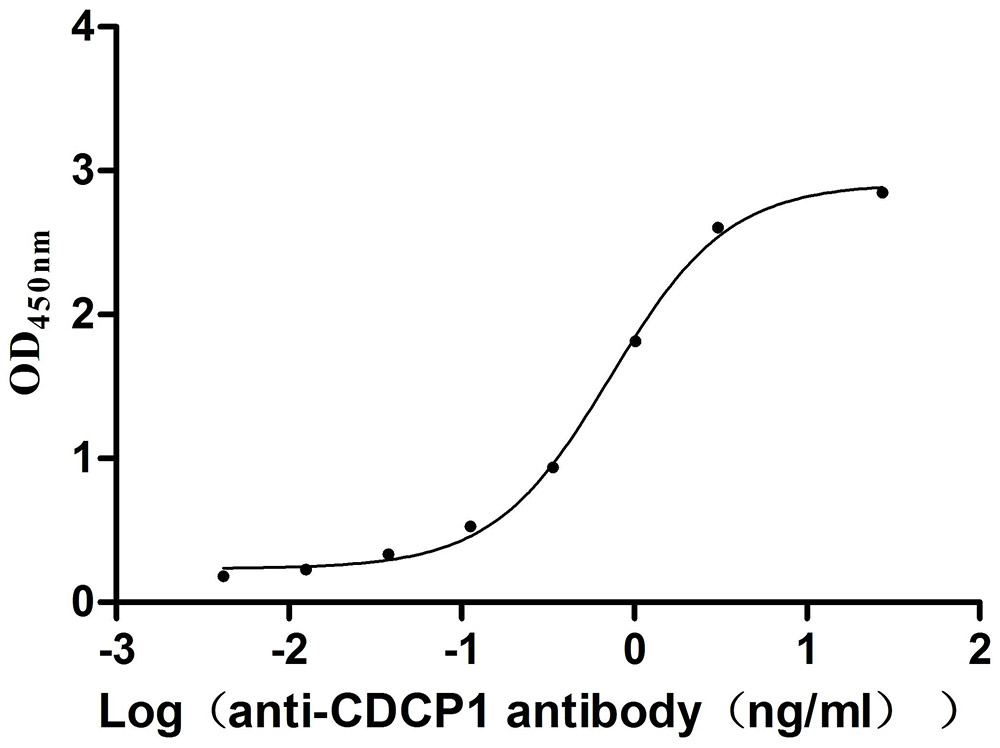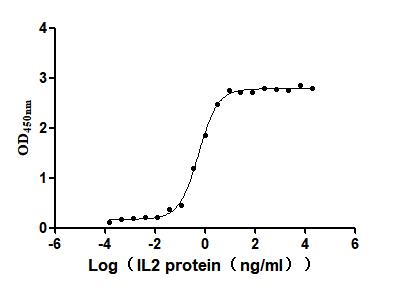Recombinant Rabies virus Glycoprotein (G), partial
-
中文名称:Recombinant Rabies virus Glycoprotein (G), partial
-
货号:CSB-YP357453RAG1
-
规格:
-
来源:Yeast
-
其他:
-
中文名称:Recombinant Rabies virus Glycoprotein (G), partial
-
货号:CSB-EP357453RAG1
-
规格:
-
来源:E.coli
-
其他:
-
中文名称:Recombinant Rabies virus Glycoprotein (G), partial
-
货号:CSB-EP357453RAG1-B
-
规格:
-
来源:E.coli
-
共轭:Avi-tag Biotinylated
E. coli biotin ligase (BirA) is highly specific in covalently attaching biotin to the 15 amino acid AviTag peptide. This recombinant protein was biotinylated in vivo by AviTag-BirA technology, which method is BriA catalyzes amide linkage between the biotin and the specific lysine of the AviTag.
-
其他:
-
中文名称:Recombinant Rabies virus Glycoprotein (G), partial
-
货号:CSB-BP357453RAG1
-
规格:
-
来源:Baculovirus
-
其他:
-
中文名称:Recombinant Rabies virus Glycoprotein (G), partial
-
货号:CSB-MP357453RAG1
-
规格:
-
来源:Mammalian cell
-
其他:
产品详情
-
纯度:>85% (SDS-PAGE)
-
基因名:G
-
Uniprot No.:
-
别名:G; Glycoprotein
-
种属:Rabies virus (strain Pasteur vaccins / PV) (RABV)
-
蛋白长度:Partial
-
蛋白标签:Tag type will be determined during the manufacturing process.
The tag type will be determined during production process. If you have specified tag type, please tell us and we will develop the specified tag preferentially. -
产品提供形式:Lyophilized powder
Note: We will preferentially ship the format that we have in stock, however, if you have any special requirement for the format, please remark your requirement when placing the order, we will prepare according to your demand. -
复溶:We recommend that this vial be briefly centrifuged prior to opening to bring the contents to the bottom. Please reconstitute protein in deionized sterile water to a concentration of 0.1-1.0 mg/mL.We recommend to add 5-50% of glycerol (final concentration) and aliquot for long-term storage at -20℃/-80℃. Our default final concentration of glycerol is 50%. Customers could use it as reference.
-
储存条件:Store at -20°C/-80°C upon receipt, aliquoting is necessary for mutiple use. Avoid repeated freeze-thaw cycles.
-
保质期:The shelf life is related to many factors, storage state, buffer ingredients, storage temperature and the stability of the protein itself.
Generally, the shelf life of liquid form is 6 months at -20°C/-80°C. The shelf life of lyophilized form is 12 months at -20°C/-80°C. -
货期:Delivery time may differ from different purchasing way or location, please kindly consult your local distributors for specific delivery time.Note: All of our proteins are default shipped with normal blue ice packs, if you request to ship with dry ice, please communicate with us in advance and extra fees will be charged.
-
注意事项:Repeated freezing and thawing is not recommended. Store working aliquots at 4°C for up to one week.
-
Datasheet :Please contact us to get it.
相关产品
靶点详情
-
功能:Attaches the virus to host cellular receptor, inducing endocytosis of the virion. In the endosome, the acidic pH induces conformational changes in the glycoprotein trimer, which trigger fusion between virus and cell membrane. There is convincing in vitro evidence that the muscular form of the nicotinic acetylcholine receptor (nAChR), the neuronal cell adhesion molecule (NCAM), and the p75 neurotrophin receptor (p75NTR) bind glycoprotein and thereby facilitate rabies virus entry into cells.
-
基因功能参考文献:
- results demonstrate that G-mediated dendritic cell activation is regulated by the ectodomain while the level of G expression by the cytoplasmic tail domain PMID: 28161580
- Characterization of epitopes on the rabies virus glycoprotein by selection and analysis of escape mutants has been described. PMID: 27132040
- Data suggest that two copies of the glycoprotein gene could be a potential candidate in the development of novel inactivated rabies vaccines. PMID: 24498294
- N-glycosylation at position 37, but not at position 146 of G protein reduces pathogenicity. PMID: 24177272
- G proteins lacking an N-glycan at Asn(319) failed to fold into their correct structure and lost their fusion activity, indicating that Asn(319) N-glycosylation is important for the functional expression of street virus G proteins. PMID: 23114627
- human PCBP2 specifically and selectively interacts with rabies virus glycoprotein mRNA and this interaction may contribute to the post-transcriptional regulation of glycoprotein expression PMID: 22438951
- N-glycosylation sites in the G protein is one of the determinants of the pathogenicity of rabies virus. PMID: 22248643
- The authors conclude that the expression level of the glycoprotein gene does have an impact on pathogenicity but is not a dominant factor that determines pathogenicity. PMID: 21068252
- R333Q mutation in the G protein is crucial for the attenuation of Flury rabies virus in mice. PMID: 20538851
- attenuation of rabies virus requires expansion of the set of host PDZ proteins with which G interacts, which interferes with the finely tuned homeostasis required for survival of the infected neuron PMID: 20086240
- Amino acid substitutions of G protein affect efficiency of cell-to-cell spread but not apoptosis-inducing ability. PMID: 20377742
- concluded that functional maturation of G protein to acquire fusogenic activity is correlated with 1-30-44 epitope formation PMID: 15557743
- trimerization is required for efficient interaction with p75NTR PMID: 16099913
- results presented here show that at least three amino acids at positions 242, 255 and 268 of the G protein are essential for the pathogenicity of the Nishigahara strain PMID: 16188341
- We confirmed that an arginine at position 333 in G protein contributed to reversion of the pathogenicity in a highly attenuated HEP-Flury strain of rabies virus. PMID: 16473429
显示更多
收起更多
-
亚细胞定位:Virion membrane; Single-pass type I membrane protein.
-
蛋白家族:Lyssavirus glycoprotein family
-
数据库链接:
KEGG: vg:1489856
Most popular with customers
-
Recombinant Mouse Retinol-binding protein 4 (Rbp4) (Active)
Express system: Mammalian cell
Species: Mus musculus (Mouse)
-
Recombinant Mouse CUB domain-containing protein 1 (Cdcp1), partial (Active)
Express system: Mammalian cell
Species: Mus musculus (Mouse)
-
Recombinant Human Interleukin-2 (IL2) (Active)
Express system: Mammalian cell
Species: Homo sapiens (Human)














